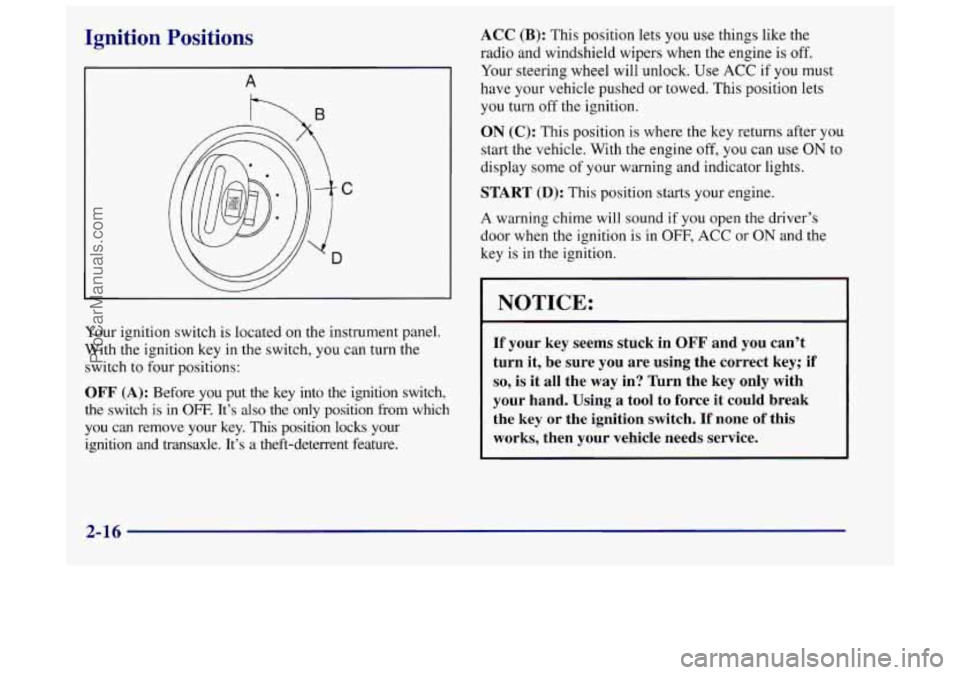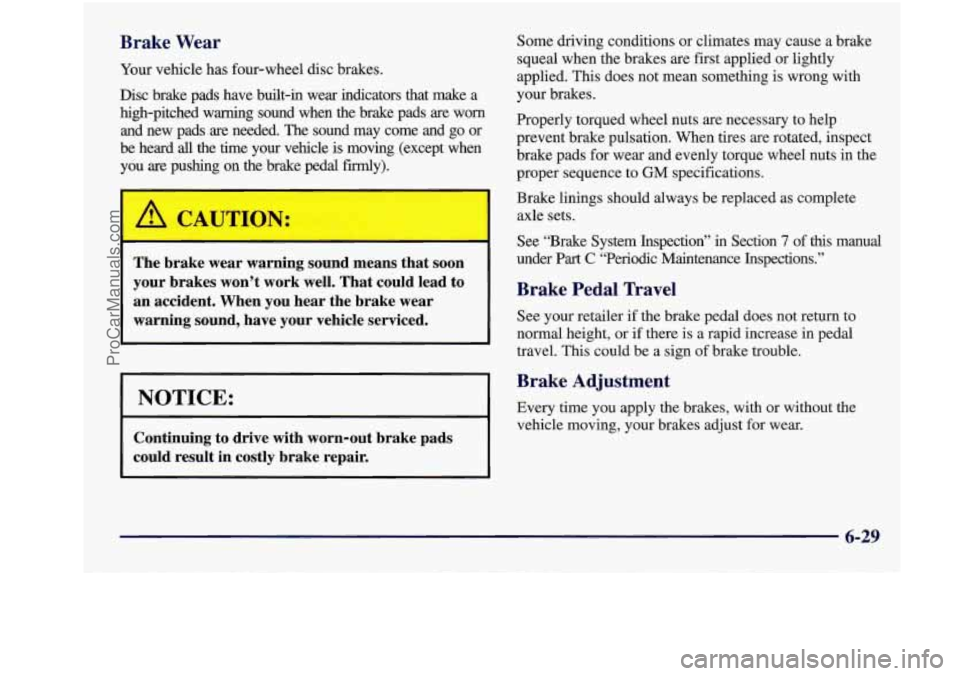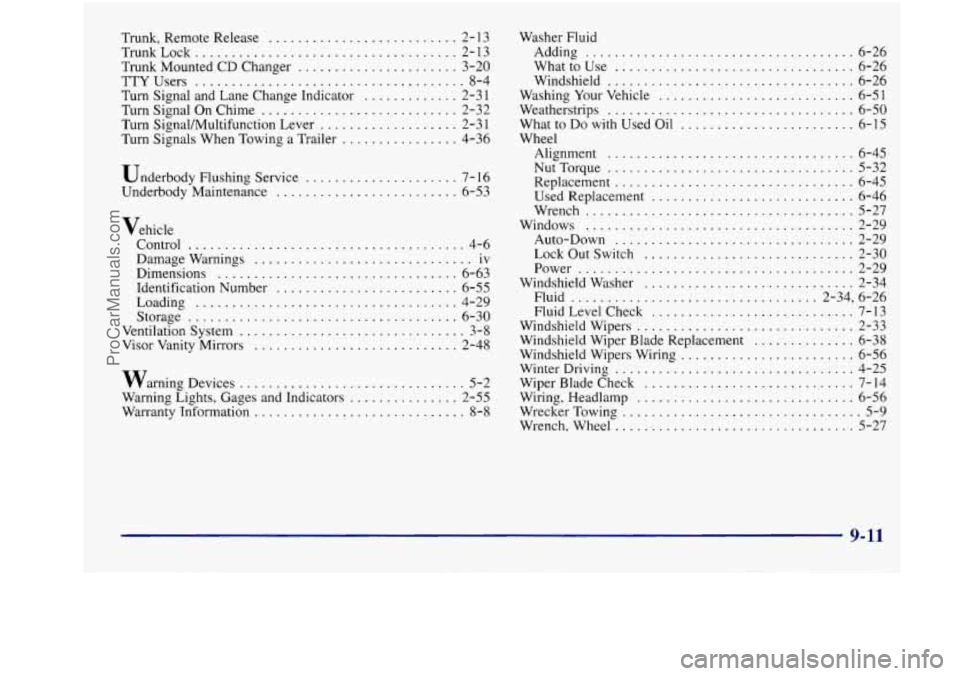service indicator OLDSMOBILE INTRIGUE 1998 Owners Manual
[x] Cancel search | Manufacturer: OLDSMOBILE, Model Year: 1998, Model line: INTRIGUE, Model: OLDSMOBILE INTRIGUE 1998Pages: 340, PDF Size: 17.93 MB
Page 76 of 340

Ignition Positions
A
hB
Your ignition switch is located on the instrument panel.
With the ignition key
in the switch, you can turn the
switch to four positions:
OFF (A): Before you put the key into the ignition switch,
the switch is in OFF. It’s also the only position from which
you can remove your
key. This position locks your
ignition and transaxle. It’s a theft-deterrent feature.
ACC (B): This position lets you use things like the
radio and windshield wipers when the engine is off.
Your steering wheel will unlock. Use
ACC if you must
have your vehicle pushed
or towed. This position lets
you turn off the ignition.
ON (C): This position is where the key returns after you
start the vehicle. With the engine
off, you can use ON to
display some of your warning and indicator lights.
START (D): This position starts your engine.
A warning chime will sound if you open the driver’s
door when the ignition is in OFF, ACC or ON and the
key is in the ignition.
NOTICE:
If your key seems stuck in OFF and you can’t
turn it, be sure you are using the correct key; if
so, is it all the way in? Turn the key only with
your hand. Using
a tool to force it could break
the key
or the ignition switch. If none of this
works, then your vehicle needs service.
2-16
ProCarManuals.com
Page 120 of 340

Low Coolant Warning Light
If this light comes on, your
system is low on coolant
and the engine may
overheat. See “Engine
Coolant” in the Index and
have your vehicle serviced
as soon as you can.
This light will come on briefly when the ignition is
turned to
ON.
Malfunction Indicator Lamp (Service
Engine
Soon Light)
SERVICE
ENGINE
SOON
Your vehicle is equipped
monitors operation
of the
fuel, ignition and emission
control systems.
~ with a computer which This system
is called OBD
I1 (On-Board
Diagnostics-Second Generation) and is intended to assure
that emissions are at acceptable levels for the life of the
vehicle, helping to produce a cleaner environment. The
SERVICE ENGINE SOON light comes on and a chime
will sound to indicate that there is a problem and service
is required. Malfunctions often will be indicated by the
system before any problem is apparent. This may prevent
more serious damage to your vehicle. This system
is also
designed to assist your service technician in correctly
diagnosing any malfunction.
NOTICE:
If you keep driving your vehicle with this light
on, after
a while, your emission controls may not
work as well, your fuel economy may not be as
good and your engine may not run
as smoothly.
This could lead to costly repairs that may not be
covered
by your warranty.
2-60
ProCarManuals.com
Page 125 of 340

If the CHANGE OIL light comes on and stays on after
you
start the engine, have the oil changed. The light may
indicate to change the oil sooner than suggested in your
maintenance schedule, depending on your driving patterns.
This light will come on when the system predicts that the
oil’s remaining useful life is almost up. It alerts you to
change the oil on a schedule consistent with your vehicle’s \
driving conditions. Therefore,
you should change your oil
at the intervals recommended in your maintenance
schedule or when the CHANGE
OIL light comes on,
whichever comes first. See “Engine Oil, When to Change”
and “Maintenance Schedule,” in the Index.
To reset the CHANGE
OIL light, see “Engine Oil” in
the Index.
Fuel Gr 2
0
Your fuel gage tells you
about how much fuel
you
have left when the ignition
is on. When the indicator
nears EMPTY
(E), you still
have a little fuel left,
but
you should get more soon.
Here are some things owners ask about. All these
situations are normal and do not show
a problem with
your fuel gage:
At the service station, the pump shuts off before the
gage reads
FULL (F).
It takes a little more or less fuel to fill up than the gage
indicated.
For example, the gage may have indicated
the tank was half full, but it actually took a little more
or less than half
the tank’s capacity to fill it.
The gage moves a little when you turn the corner or
speed
up.
2-65
ProCarManuals.com
Page 153 of 340

Care of Your Cassette Tape Player
A tape player that is not cleaned regularly can cause
reduced sound quality, ruined cassettes or a damaged
mechanism. Cassette tapes should be stored in their
cases away from contaminants, direct sunlight and
extreme heat. If they aren’t, they may not operate
properly
or may cause failure of the tape player.
Your tape player should be cleaned regularly after every
50 hours of use. Your radio may display CLN to indicate
that you have used your tape player for
50 hours without
resetting the tape clean timer. If this message appears on
the display, your cassette tape player needs to be
cleaned. It will still play tapes, but you should clean it as
soon as possible to prevent damage to your tapes and
player. If you notice a reduction in sound quality, try a
known good cassette to
see if it is the tape or the tape
player at fault. If this other cassette has no improvement
in sound quality, clean the tape player.
The recommended cleaning method for your cassette
tape player is the use of a scrubbing action,
non-abrasive cleaning cassette with pads which scrub
the tape head as the hubs of the cleaner cassette turn.
The recommended cleaning cassette is available through
your retail facility
(GM Part No. 12344789).
When using a scrubbing action, non-abrasive cleaning
cassette, it is normal for the cassette to eject because
your unit is equipped with
a cut tape detection feature
and a cleaning cassette may appear as a broken tape.
If
the cleaning cassette ejects, insert the cassette at least
three times to ensure thorough cleaning.
You may also choose a non-scrubbing action, wet-type
cleaner which uses a cassette with a fabric belt to clean
the tape head. This type of cleaning cassette will not
eject on
its own. A non-scrubbing action cleaner may
not clean as thoroughly
as the scrubbing type cleaner.
The use of a non-scrubbing action, dry-type cleaning
cassette
is not recommended.
After you clean the player, press and hold EJECT for
five seconds
to reset the CLN indicator. The radio will
display
--- to show the indicator was reset.
Cassettes
are subject to wear and the sound quality
may degrade over time. Always make sure the cassette
tape is in good condition before you have your tape
player serviced.
3-27
ProCarManuals.com
Page 232 of 340

If your vehicle is certified to meet California Emission
Standards (indicated on the underhood emission control
label),
it is designed to operate on fuels that meet
California specifications. If such fuels are not available
in states adopting California emissions standards, your
vehicle will operate satisfactorily on fuels meeting
federal specifications, but emission control system
performance may be affected.
The malfunction indicator
lamp on your instrument panel may turn on and/or your
vehicle may fail a smog-check test. If this occurs, return
to your authorized Oldsmobile retailer for diagnosis to
determine the cause of failure. In the event it
is
determined that the cause of the condition is the type of
fuels used, repairs may not be covered by your warranty.
Some gasolines that are not reformulated for low
emissions contain an octane-enhancing additive called
methylcyclopentadienyl manganese tricarbonyl (MMT);
ask your service station operator whether or not his fuel
contains MMT. General Motors does not recommend the
use of such gasolines. If fuels containing MMT are used,
spark plug life may be reduced and your emission
control system performance may be affected. The
malfunction indicator lamp on your instrument panel
may turn on. If this occurs, return to your authorized
Oldsmobile retailer for service.
To provide cleaner air, all gasolines in the United States
are now required to contain additives that will help
prevent deposits from forming in your engine and fuel
system, allowing your emission control system to
function properly. Therefore, you should not have to add
anything to the fuel. In addition, gasolines containing
oxygenates, such as ethers and ethanol, and
reformulated gasolines may be available in your area to help clean the air. General Motors recommends that you
use these gasolines if they comply with the
specifications described earlier.
NOTICE:
Your vehicle was not designed for fuel that
contains methanol. Don’t use it. It can corrode
metal parts in your fuel system and
also damage
plastic and rubber parts. That damage wouldn’t
be covered under your warranty.
6-4
ProCarManuals.com
Page 257 of 340

Brake Wear
Your vehicle has four-wheel disc brakes.
Disc brake pads have built-in wear indicators that make a
high-pitched warning sound when the brake pads are worn and new pads are needed. The sound may come and
go or
be heard all the time your vehicle is moving (except when
you are pushing on the brake
pedal firmly).
- m--
A CAUTION:
I
The brake wear warning sound means that soon
your brakes won’t work well. That could lead to
an accident. When you hear the brake wear
warning sound, have your vehicle serviced.
NOTICE:
Continuing to drive with worn-out brake pads
could result in costly brake repair.
Some driving conditions or climates may cause a brake
squeal when the brakes are first applied or lightly
applied. This does not mean something is wrong with
your brakes.
Properly torqued wheel nuts are necessary to help
prevent brake pulsation. When tires are rotated, inspect
brake pads for wear and evenly torque wheel nuts in the
proper sequence to
GM specifications.
Brake linings should always be replaced as complete
axle sets.
See “Brake System Inspection” in Section
7 of this manual
under Part
C “Periodic Maintenance Inspections.”
Brake Pedal Travel
See your retailer if the brake pedal does not return to
normal height, or if there is
a rapid increase in pedal
travel. This could be a sign of brake trouble.
Brake Adjustment
Every time you apply the brakes, with or without the
vehicle moving, your brakes adjust for wear.
6-29
ProCarManuals.com
Page 270 of 340

When It’s Time for New Tires
One way to tell when it’s
time for new tires is to
check the treadwear indicators, which will
appear when your tires have
only
1/16 inch (1.6 mm) or
less of tread remaining.
You need a new tire if any of the following statements
are true:
You can see the indicators at three or more places
You can see cord or fabric showing through the
The tread or sidewall is cracked, cut or snagged deep
enough to show cord or fabric.
The tire has a bump, bulge or split.
The tire has a puncture, cut or other damage that
around
the tire.
tire’s rubber.
can’t be repaired well because of the size or location
of the damage.
Buying New Tires
To find out what kind and size of tires you need, look at
the Tire-Loading Information label.
The tires installed on your vehicle when it was new had
a Tire Performance Criteria Specification (TPC Spec)
number on each tire’s sidewall. When you get new tires,
get ones with that same TPC Spec number. That way
your vehicle will continue to have tires that are designed
to give proper endurance, handling, speed rating,
traction, ride and other things during normal service on
your vehicle. If your tires have an all-season tread
design, the TPC number will be followed by an
“MS”
(for mud and snow).
If you ever replace your tires with those not having a
TPC Spec number, make sure they are the same size,
load range, speed rating and construction type (bias,
bias-belted or radial) as your original tires.
6-42
ProCarManuals.com
Page 297 of 340

I Maintenance Schedule I
The services shown in this schedule up to 100,000 miles
(I 66 000 km) should be performed after 100,000 miles
(1
66 000 km) at the same intervals. The services shown
at
150,000 miles (240 000 km) should be performed at
the same interval after
150,000 miles (240 000 km).
See “Owner Checks and Services” and “Periodic
Maintenance Inspections” following.
Footnotes
? The U.S. Environmental Protection Agency or the
California Air Resources Board has determined that the
failure to perform this maintenance item will not nullify
the emission warranty or limit recall liability prior to
the completion of the vehicle‘s useful life. We, however,
urge that all recommended maintenance services
be performed at the indicated intervals and the
maintenance be recorded.
* Your vehicle has an Engine Oil Life Monitor. This
monitor will show
you when to change the engine oil
and filter
-- usually between 3,000 miles (5 000 km)
and
7,500 miles (12 500 km) since your last oil change.
Under severe conditions, the indicator may come on
before
3,000 miles (5 000 km). Never drive your vehicle
more than
7,500 miles (12 500 km) or 12 months
without an oil and filter change.
The system won’t detect dust in the oil.
So if you
drive
in a dusty area, be sure to change your oil and
filter every
3,000 miles (5 000 km) or sooner if the
CHANGE
OIL light comes on. Remember to reset the
Oil Life Monitor when the oil has been changed.
For
more information, see “Engine Oil” in the Index.
+ A good time to check your brakes is during tire
rotation. See “Brake System Inspection’’ unde.r “Periodic
Maintenance Inspections” in Part C
of this schedule.
7-5
ProCarManuals.com
Page 332 of 340

' Labels 1 ................................. Certification 4-30
Service Parts Identification ..................... 6-55
Tire-Loading Information
...................... 4-29
................... 1 Vehicle Identification Number 6-55
I Lamps Exterior
.................................... 2-38
Interior
..................................... 2-40
Last Door Closed Locking
.......................... 2-7
Lights Leaving Your Vehicle with the Engine Running ....... 2-26
Air Bag Readiness
....................... 1-21, 2-56
Anti-Lock Brake System Warning
............ 2-57, 4-7
Brake System Warning
......................... 2-56
Change Oil Light
............................. 2-64
Charging System Indicator
...................... 2-56
Enhanced Traction System Warning
.......... 2-58, 4-9
Low Coolant Warning
.................... 2-60, 6-23
Low Traction
............................ 2-59, 4-9
Low Washer Fluid Warning
..................... 2-64
Safety Belt Reminder
...................... 1-6, 2-55
Service Vehicle Soon
.......................... 2-65
Loading Your Vehicle
........................... 4-29
Lock Out Switch, Window
........................ 2-30
Interior
..................................... 2-40
Low Oil Level 2-63
...............................
Oilwarning ................................. 2-62
Security
.................................... 2-64
ServiceEngineSoon
.......................... 2-60
Lockout Prevention 2-7
..............................
Locks Cylinders
................................... 7-14
Door
........................................ 2-4
PowerDoor
.................................. 2-4
RearDoorSecurity
............................. 2-5
Loss of Control 4-14
LowOilLevelLight
............................ 2-63
Key
Lock Cylinder Service
..................... 7-14
Low Coolant Warning Light
................. 2-60, 6-23
Low Traction Light
......................... 2-59, 4-9
Lubricants and Fluids
............................ 7-18
Lubrication Service, Body
........................ 7-14
................................
Magnetic Speed Sensitive Steering ................ 4-11
Maintenance. Normal Replacement Parts
............ 6-64
Maintenance Record
............................ 7-20
Maintenance Schedule
............................ 7-1
Owner Checks and Services
..................... 7-13
Periodic Maintenance Inspections
................ 7-17
Recommended Fluids and Lubricants
............. 7-18
Scheduled Maintenance Services
.................. 7-4
Maintenance, Underbody
......................... 6-53
Maintenance When Trailer Towing
................. 4-37
Making Turns with a Trailer
...................... 4-35
Malfunction Indicator Lamp
...................... 2-60
Matching Transmitters To Your Vehicle
............. 2-11
Introduction
.................................. 7-2
ManualFrontSeat
....................,.......... l-2
Methanol ...................................... 6-4
9-6
ProCarManuals.com
Page 337 of 340

Trunk. Remote Release .......................... 2- 13
TrunkLock .................................... 2-13
Trunk Mounted CD Changer
...................... 3-20
TTYUsers
..................................... 8-4
Turn Signal and Lane Change Indicator
............. 2-3 1
Turn Signal On Chime
........................... 2-32
Turn SignalMultifunction Lever
................... 2-3 1
Turn Signals When Towing a Trailer
................ 4-36
Underbody Flushing Service
..................... 7- 16
Underbody Maintenance ......................... 6-53
Vehicle Control
...................................... 4-6
Damage Warnings
.............................. iv
Dimensions ................................. 6-63
Identification Number
......................... 6-55
Loading
.................................... 4-29
Storage
..................................... 6-30
Ventilation System
............................... 3-8
Visor Vanity Mirrors
............................ 2-48
warning Devices
............................... 5-2
Warning Lights. Gages and Indicators
............... 2-55
Warranty Information
............................. 8-8
Washer Fluid
Adding
..................................... 6-26
What to Use
................................. 6-26
Windshield
.................................. 6-26
Washing Your Vehicle
........................... 6-51
Weatherstrips
.................................. 6-50
What to
Do with Used Oil ........................ 6-15
Wheel Alignment
.................................. 6-45
NutTorque
.................................. 5-32
Replacement
................................. 6-45
Used Replacement
............................ 6-46
Wrench
..................................... 5-27
Windows
..................................... 2-29
Auto-Down
................................. 2-29
Lock Out Switch
............................. 2-30
Power
...................................... 2-29
Windshield Washer
............................. 2-34
Fluid
.................................. 2-34. 6-26
Fluid Level Check
............................ 7-13
Windshield Wipers
.............................. 2-33
Windshield Wiper Blade Replacement
.............. 6-38
Windshield Wipers Wiring
........................ 6-56
Winter Driving
................................. 4-25
Wiper Blade Check
............................. 7-14
Wiring. Headlarnp .............................. 6-56
WreckerTowing
................................. 5-9
Wrench. Wheel
................................. 5-27
9-11
ProCarManuals.com